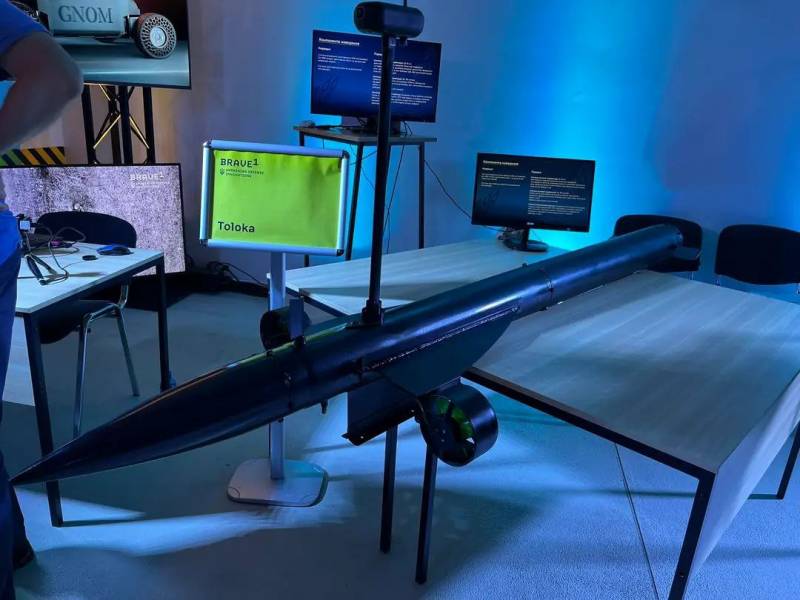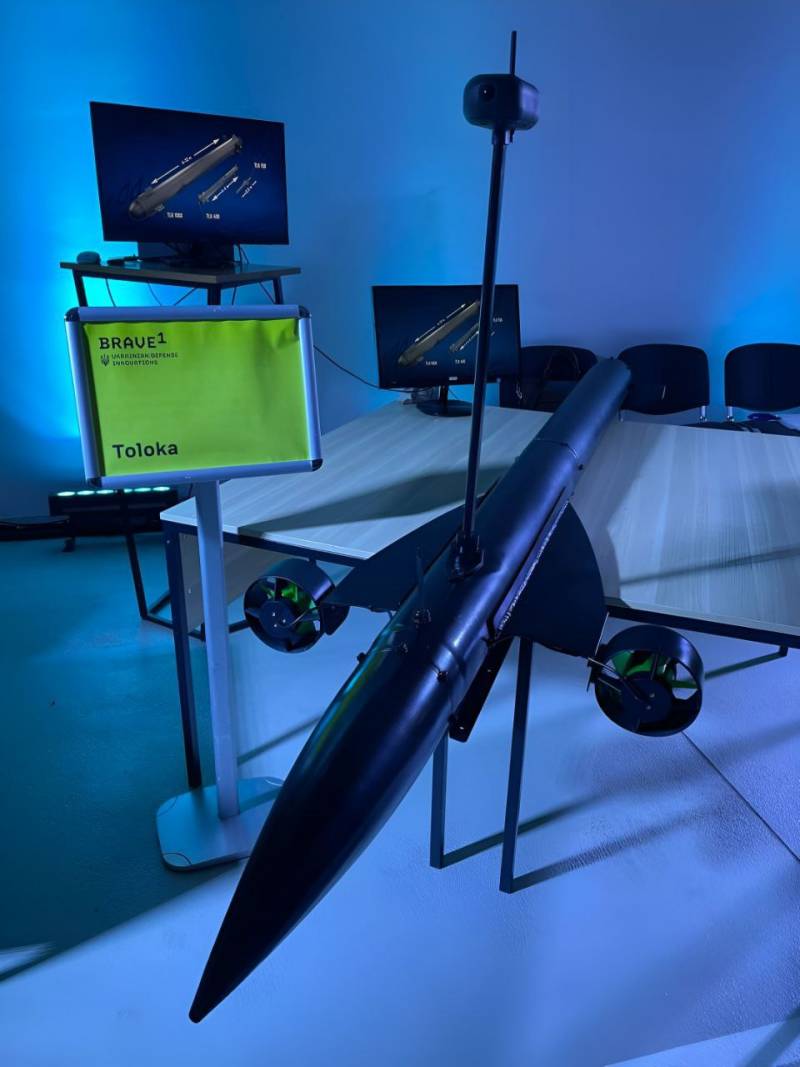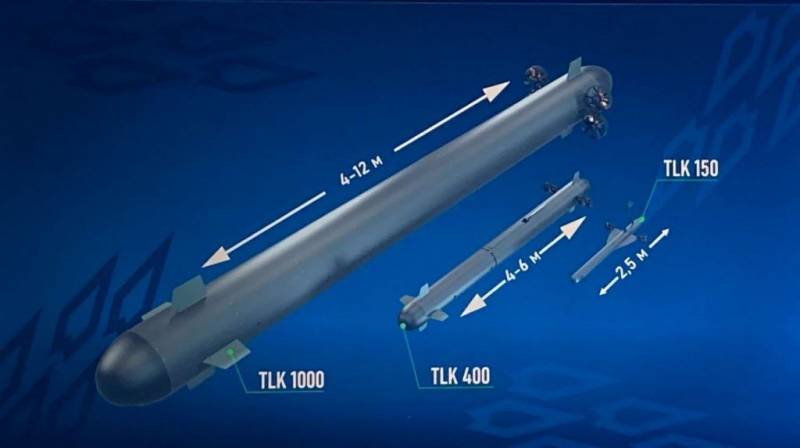Ukrainian project of the family of unmanned underwater vehicles "Toloka"

Model or prototype of the product "Toloka" TLK 150, rear-side view
On its own and with foreign help, Ukraine is still trying to create new types of weapons. In particular, the direction of unmanned underwater vehicles for reconnaissance and / or strike purposes is being worked out. The other day it became known that one of the Ukrainian state organizations is creating a project for a whole family of similar equipment called Toloka.
family on display
Recently, the so-called. state defense cluster Brave-1. The task of this organization is to search, support and develop promising projects in the field of armaments, military equipment, etc. This "advanced development agency" has already supported several projects, but the mass introduction of new designs is still far away.
A few days ago, the Bravo-1 cluster held an exhibition during which the developments that received support were demonstrated. Soon, photographs of new samples appeared on specialized resources, incl. previously unknown. In particular, the exhibition featured materials on the Toloka family of underwater vehicles. One of them was shown using a full-scale layout or a prototype. The rest were present only in graphical form, as three-dimensional models.
According to reports, the Toloka project proposes the development of a family of uninhabited attack submersibles. In fact, we are talking about some kind of analogue of conventional torpedoes, but with its own characteristics and specifics. There are currently three specimens in the family. They differ from each other in size, displacement, load and running characteristics. Some of the parameters of such devices are disclosed in the presented materials.
The current state of the project and its prospects are unknown. For an exhibition or for testing, a mock-up or a full-fledged prototype of one of the devices, designated as TLK 150, was made. Perhaps, tests are already planned to work out the design and operation features. In foreign sources, there are also bolder assessments - up to the preparation of combat use.
The larger and heavier TLK 400 and TLK 1000 products are shown as graphics only. In addition, some of their characteristics are indicated not exactly, but as a possible range. All this indicates that the projects are at the stage of preliminary development.
Breadboard sample
The exhibition showed the smallest sample of the family - the TLK 150. It is curious that it differs from the other two Toloka products not only in size, but also in architecture. It has a different design of the hull and external devices, differs in the location of the propeller groups, etc. Probably, such differences in the designed devices are due to the specifics of the layout and other factors.
The TLK 150 has a cylindrical hull with a hemispherical nose fairing and an ogival stern. In the bow, the depth rudders of a small area are placed. In the middle part, with an offset to the stern, there are three swept planes - two horizontal "half-wings" and a lower "keel". The total length of such an apparatus reaches 2,5 m. The mass / displacement is not reported, however, the possibility of installing a warhead weighing from 20 to 50 kg is declared. Accordingly, the entire assembly can weigh at least 80-100 kg.

The smallest Toloka apparatus is fully electric. On board there are batteries that ensure the movement and operation of on-board equipment. For movement, two electric motors with screws in the annular channels, mounted on the ends of the horizontal stabilizer, must be used. The range is said to reach 100 km. The speed is not reported.
Apparently, TLK 150 uses telecontrol. A tubular mast is provided above the planes on the body, on which a video camera and an antenna are placed. The device should move at a shallow depth, raising the camera above the surface. The operator gets the opportunity to monitor the surrounding space, as well as point the device at the target. Two-way communication must be supported by radio.
Major Representatives
Also proposed is the general appearance of larger underwater vehicles - TLK 400 and TLK 1000. Judging by the lack of clear characteristics, they still exist only as a concept. Perhaps, with a favorable development of events, these projects will be brought to at least mock-ups.
Products "400" and "1000" have a similar appearance and common architecture. They are proposed to be built in cylindrical cases of large elongation, capable of accommodating all the necessary devices. The nose cone is presumably made transparent for sonar signals. Behind it there is a set of four planes - probably rudders. The central swept planes, as in the TLK 150, are absent. In the stern are vertical stabilizers and four motors. The layout of the propulsion system for the two vehicles is slightly different.
An “average” underwater vehicle, according to Bravo-1, can have a length of 4 to 6 m. It will be possible to place warheads weighing up to 500 kg on board, which also indicates the possible weight of the structure. The speed was not named, and the range was determined at 1200 km. Such characteristics should be provided by some kind of hybrid power plant.
The TLK 1000 is available in 4 to 12 m body lengths with the appropriate diameter. The displacement will be several tons, of which 5 tons will fall on warheads. With the help of a hybrid power plant, they are going to get a range of up to 2 thousand km. They want to equip the device with a hydroacoustic guidance system for independent search and attack of targets.
Unusual torpedoes
The Bravo-1 organization positions samples of the Toloka family as uninhabited underwater vehicles with a shock function. In fact, we are talking about torpedoes of a specific appearance. By design and declared characteristics, they differ from traditional torpedoes, but they must solve similar problems, incl. on similar principles.
The reasons for the emergence of such projects are quite clear. The Kiev regime wants to attack Russian ships and coastal facilities, but in fact does not have the capacity to do so. Its "regular" fleet has been destroyed, and unmanned kamikaze boats or unmanned aerial vehicles are unable to cope with the tasks. Therefore, Ukrainian engineers are trying to master a new underwater environment.

The whole family is assembled
To date, only one version of Toloka, the TLK 150, has reached the stage of assembling a layout or a full-fledged prototype. This is a remotely controlled vehicle with limited dimensions and corresponding running and combat capabilities. It is quite possible that in the near future they will try to bring such equipment to at least a small series and use it against our objects.
It is obvious that such a sample, despite the declared characteristics, does not pose a particular danger to the Black Sea fleet and coastal infrastructure facilities. Toloka uses radio remote control, which can be detected and suppressed. In addition, there is a technical possibility to reveal the position of the operator - with understandable consequences. With all this, the ability of such a device to pass through the barriers protecting the bases of the fleet raises doubts.
The same is true for the medium vehicle TLK 400. Higher driving performance and increased warhead mass are offset by vulnerability to electronic warfare or anti-submarine systems. In addition, there is no reason to believe that this apparatus is capable of passing through barriers.
The most interesting is the heavy TLK 1000, for which special characteristics of range and power, as well as the use of homing, are declared. It may be protected from radio channel suppression, but its size and other features will make it easier to find or intercept it. In addition, when used within the Black Sea, the specifications of this product are redundant.
Two larger devices are characterized by increased complexity, which negatively affects their prospects. Ukrainian designers managed to make a model or prototype of the light Toloka, but the possibility of building larger samples is in question. Serial production in the current conditions is virtually excluded. Accordingly, the probability of the appearance and combat use of such devices tends to zero.
However, it cannot be ruled out that foreign specialists are involved in the development of the family of devices. In addition, foreign assistance is also possible at the production stage. It was in this way that the release of unmanned kamikaze boats was organized last year. However, foreign roots did not affect the results of using such a technique. The same should be expected with the new Toloka project.
Available means
In general, the Toloka project at the moment looks like another frantic attempt to solve an urgent problem with the limited means available. In the “cluster” Bravo-1, they were only able to draw a few samples of weapons of an unusual appearance and assemble one layout, but all their advantages and high characteristics are still present only on paper or in digital form.
It cannot be ruled out that they will try to bring the simplest samples of the presented family to production and even use them against the Russian fleet or coastal infrastructure. However, the effectiveness of such devices is questionable. Moreover, given the current situation, one can doubt even the possibility of their appearance in our waters. However, the low probability of Ukrainian success does not negate the need to protect important areas and create new means of protection.
Information